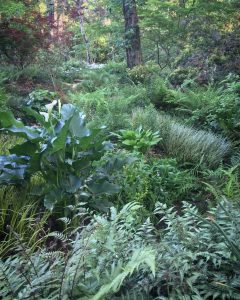
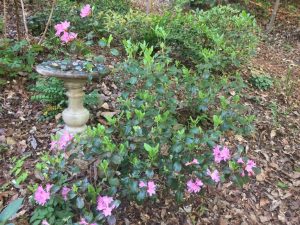 f you don’t have an irrigation system, try to hand water early in the day. Water slowly to avoid runoff and to allow the water to penetrate.
f you don’t have an irrigation system, try to hand water early in the day. Water slowly to avoid runoff and to allow the water to penetrate.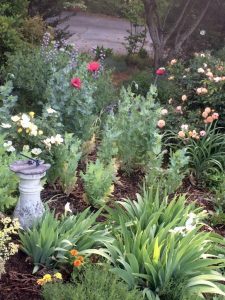

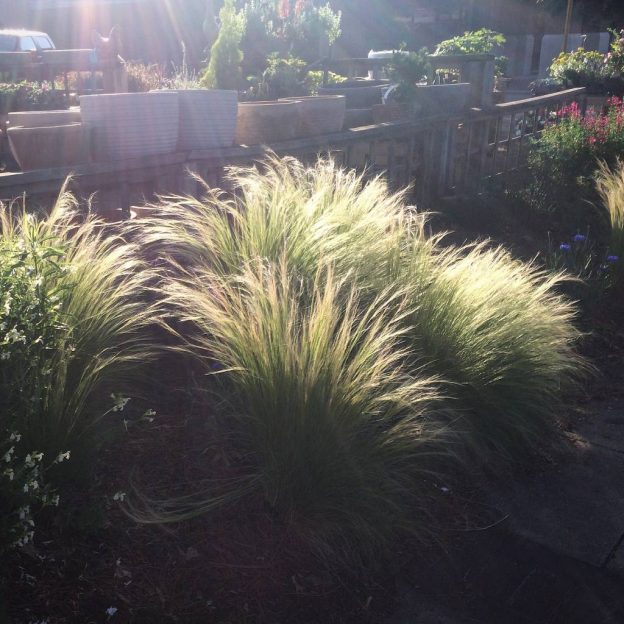

 f you don’t have an irrigation system, try to hand water early in the day. Water slowly to avoid runoff and to allow the water to penetrate.
f you don’t have an irrigation system, try to hand water early in the day. Water slowly to avoid runoff and to allow the water to penetrate.
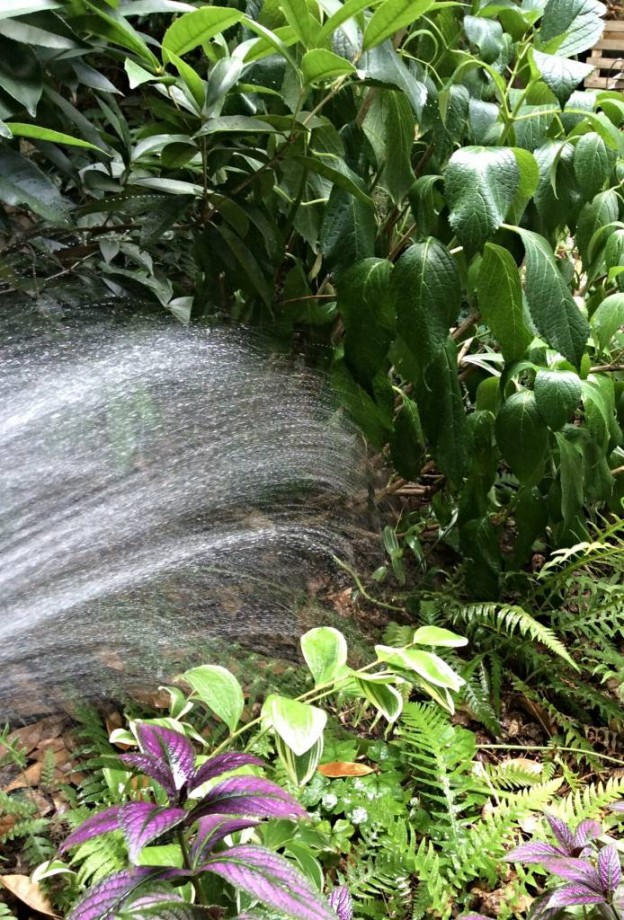
Well, here we are again. Though we’ve been fortunate in the Birmingham area and southeast the past years to have sufficient rainfall for our landscapes, this summer has been a different story. Warmer than normal temperatures and lack of measurable precipitation spell worsening drought conditions and the need for water conservation.
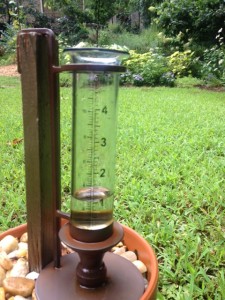 So, what does this mean for you? Well, trees and shrubs that have been planted less than a year are the most susceptible and may be lost due to stress from lack of rain. If your landscape is established with plants that have been well placed and are healthy, drought conditions hopefully won’t have as much of an impact – though if these conditions persist that may change too.
So, what does this mean for you? Well, trees and shrubs that have been planted less than a year are the most susceptible and may be lost due to stress from lack of rain. If your landscape is established with plants that have been well placed and are healthy, drought conditions hopefully won’t have as much of an impact – though if these conditions persist that may change too.
A good practice under normal conditions is to water no more than twice a week in any one area. With Birmingham Water Works Stage 3 watering restrictions in place, hand watering is allowed twice a week and irrigation systems allowed once a week for one hour between 8pm and 8am.
Assess your landscape and prioritize which perennials, shrubs, and trees require the most attention. Add mulch to existing plantings to conserve moisture. Hold off on doing any activity that will push growth (i.e. fertilizing and pruning) until rains come. Deadhead plants with old blooms, especially hydrangeas, and strip leaves from stems if they’re not too large. Set out soaker hoses.
Conserve water in your home as well. When water is heating up for showers, collect it in a bucket for watering plants. It’s amazing how much water you can get from this simple step. Don’t let water run when hand washing dishes or brushing teeth, and run the dishwasher and do laundry only when there are full loads.
You’ve no doubt seen the symptoms of drought stress on shrubs and trees as leaves wilt, curl, and eventually drop. Evergreens show signs by turning brown at the tips, eventually moving into the center of the plant. Injury to trees can be sudden or may take up to two years to be revealed, so even after this drought ends it will be important to monitor the health of our landscapes.
One thing is certain. Even after the rains return, we must be mindful of the way we use water for our landscapes and in our homes, continuing to be good stewards of our environment, now and in the future.
By Kris Blevons
Some helpful links:
https://www.bwwb.org/sites/default/files/docs/doc-dmpsummary.pdf
https://birminghamgardeningtoday.com/water-conservation-now/
http://www.aces.edu/urban/metronews/vol6no4/gardens.html
http://www.al.com/living/index.ssf/2016/06/dealing_with_a_dry_spell_garde_2.html
Recently the weathermen called for a pretty decent chance of rain, which, fortunately, finally did materialize. Now, if you’re in the Birmingham area and are a homeowner or even just have a small plot to garden, you were well aware, prior to the welcome rain showers of recent days, that it was getting pretty darn dry out there. And, if you, like me, don’t have an irrigation system, that means dragging around hoses.
Personally I don’t mind this. Of course, it might be better if I weren’t watering pretty extensively by hand early in the morning at home, when it’s needed, then arriving at Oak Street Garden Shop, my home away from home, and, you guessed it, immediately pulling out the hoses to water the plant inventory on these long, hot late summer days.
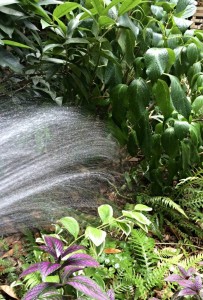
Hydrangeas are the first to wilt from lack of water…
Truthfully, though, I sort of like hand watering. Sure, I could set the sprinkler to run (My husband prefers this since he has other things he’d rather be doing.), or set out soaker hoses to get water right where it’s needed at the roots. If I had an irrigation system, it would surely save a lot of time and energy…assuming it was set to run properly at the correct intervals. (Now that I really think about it, I believe having an irrigation system would cause me more anxiety, since I would need to know that everything was set just right and was still working during really dry spells.)
No, watering by hand keeps me in touch with what’s going on in my personal plant kingdom, and I also really appreciate this quiet time to just be still and think. Moving from plant to plant and back again, trying to water as deeply as possible, (Watering less frequently but deeply should be the goal.) I see things more closely, and make mental notes of things I may need to address. Overwatering kills more plants than underwatering. When roots of a plant are waterlogged and can’t get oxygen, they basically drown, and, even though they’ll look like they need water (wilted leaves), no amount of water will bring them back.
Sometimes plants wilt simply because they’re hot and will begin to revive by evening. Plants that have gone past the point of very, very dry when finally watered will have many yellow leaves…a sign of stress. It’s best if you can learn to water before a plant gets so dry. This means getting to know what your individual plants want. But, if you’re not sure, it’s always better to err on the side of more dry than too wet, unless they’re bog plants or those you know want consistently wet soil.
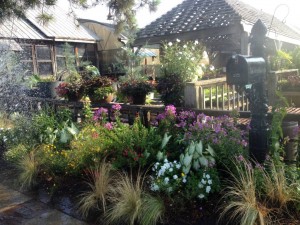
Water as early in the day as possible…
As I water, I think back to the drought of 2007. Surprisingly, most of my perennials, shrubs, and trees did indeed survive that awful summer, and I learned a hard lesson on how better to read each one for signs of stress, hose in hand. It was like a personal watering triage each time I pulled the hose out. Water the hydrangeas more…those spiraeas will need less…skip over the yuccas, rosemary and sedums… Thankfully, now hand watering is once again a more relaxing endeavor.
Irrigation systems do make life easier, for sure. But, when I see them running irresponsibly, either during the hottest portion of the day (So much water is wasted, evaporating into thin air.) or in the midst of rain storms, it worries me. Water is a valuable resource, and we all need to remember to be responsible in our water usage, whether it be inside our homes or out. Install a rain sensor on your system if you haven’t already.
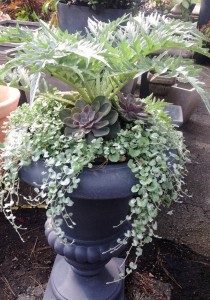
This planting is easy to hand water since it needs to be dry…
The inventory at Oak Street Garden Shop is watered individually, by hand daily, and this has turned out to be quite efficient. We decided to completely dismantle the entire irrigation system a number of years ago, and now we water exactly what needs it. No more groups of plants getting too much water while others parch. I prefer this and feel more like a steward of my plants, both at home and at work. For me, it’s more personal, and I like that.
If you have an irrigation system, please use it responsibly. Know how it works and have it checked regularly by a professional irrigation specialist. As your trees and shrubs grow, sprinkler heads often need to be adjusted to continue to water efficiently. Irrigation systems can definitely be wonderful additions in helping maintain your landscape when properly installed and monitored. Take a look HERE for more information.
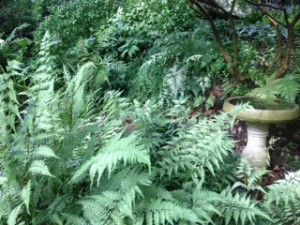 With 2013 beginning with a wet, cool spring and the rain continuing into early summer, it seemed like we’d been transported into a different universe than Alabama, didn’t it? All the rain may have caused some complacency – everything seems so much lusher than it usually is this time of year…now the heat is here, though, and it seems certain we’ll be entering our usual summer pattern of hit and miss rain showers with lots of warmth and humidity…
With 2013 beginning with a wet, cool spring and the rain continuing into early summer, it seemed like we’d been transported into a different universe than Alabama, didn’t it? All the rain may have caused some complacency – everything seems so much lusher than it usually is this time of year…now the heat is here, though, and it seems certain we’ll be entering our usual summer pattern of hit and miss rain showers with lots of warmth and humidity…
 Established plantings in your landscape should be doing well, but be aware that new plantings of shrubs, trees and perennials will need supplemental watering this first summer – pay attention to them. The requirement for new plantings is an inch of water each week.
Established plantings in your landscape should be doing well, but be aware that new plantings of shrubs, trees and perennials will need supplemental watering this first summer – pay attention to them. The requirement for new plantings is an inch of water each week.
It’s also a good idea to group plants together that need the same amounts of moisture. For example, you wouldn’t want to place a water loving Japanese Iris in the same bed as sedums…one will surely die from too much, while the other may not receive enough. Either way, it’s not a good scenario!
When you determine that new plantings or even established ones in your landscape need water, remember that the early morning hours are the best time. If you have an irrigation system, schedule it to run between 4 a.m and 7 a.m. or handwater as early in the day as you can.
All gardeners should be aware of conserving water, and an easy way to save water and money, if you have an irrigation system, is to install a water sensor. It will detect when the landscape is receiving moisture and will shut off your system, so you’re not one of those watering your lawn when it’s raining! It’s one of those easy fixes everyone with an irrigation system should be aware of.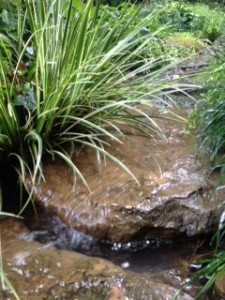
If you handwater using a hose, direct the water onto the soil, not over the foliage of the plant. The goal is to water deeply but infrequently, so the roots of your plants travel down into the soil looking for moisture. Too many short watering cycles will create shallow root systems that are less able to withstand dry periods.
A very good resource for irrigation and other landscape information is available at http://www.aces.edu/pubs/docs/A/ANR-1359/index2.tmpl, the Alabama Cooperative Extension System’s Manual on Alabama Smart Yards, authored by Dr. Ken Tilt of Auburn.